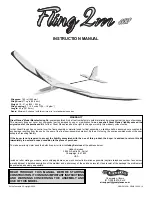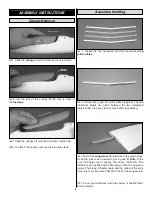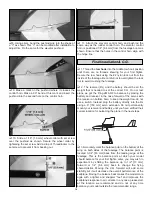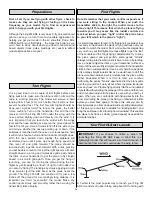
❏
1. Check the C.G. according to the measurements
provided in the manual.
❏
2. Be certain the battery and receiver are securely
mounted in the fuse. Simply stuffing them into place
with foam rubber is not sufficient.
❏
3. Extend your receiver antenna and make sure it has a
strain relief inside the fuselage to keep tension off the
solder joint inside the receiver.
❏
4.
Balance your model
laterally as explained in the instructions.
❏
5. Use thread-locking compound to secure critical
fasteners such as the set screws that hold the wheel
axles to the struts, screws that hold the carburetor arm (if
applicable), screw-lock pushrod connectors, etc.
❏
6. Reinforce holes for wood screws with thin CA where
appropriate (servo mounting screws, cowl mounting
screws, etc.).
❏
7. Confirm that all controls operate in the correct direction
and the throws are set up according to the manual.
❏
8. Make sure there are silicone retainers on all the
clevises and that all servo arms are secured to the
servos with the screws included with your radio.
❏
9. Secure connections between servo wires and
Y-connectors or servo extensions, and the
connection between your battery pack and the on/off
switch with vinyl tape, heat-shrink tubing or special
clips suitable for that purpose.
❏
10. Make sure any servo extension cords you may have
used do not interfere with other systems (servo arms,
pushrods, etc.).
❏
11. Place your name, address, AMA number and
telephone number on or inside your model.
❏
12. Cycle your receiver battery pack (if necessary) and
make sure it is fully charged.
❏
13. If you wish to photograph your model, do so before
your first flight.
❏
14. Range check your radio when you get to the flying field.
Mount the wing to the fuselage with the supplied rubber bands.
Install them from front to back, crisscrossing the last two. Never
use torn, cracked or oily rubber bands. After removing the rubber
bands from your model, store them in a container with talcum
powder or clay-type kitty litter to absorb oil and keep them fresh
for the next flying session.
If the rubber bands you will be using are different from those
supplied with the ARF, consult an experienced modeler to make
certain they are strong enough, and that you have used enough
of them. If uncertain, force the front of the wing off of the wing
saddle.There should be considerable resistance! If the wing can
be forced from the fuselage without having to strain your hands,
then there are probably not enough rubber bands.
The Fling 2M ARF is a great flying model that flies smoothly and
predictably. The Fling 2M ARF does not, however, possess the
self-recovery characteristics of a primary R/C trainer and should
be flown only by experienced R/C pilots.
CAUTION (THIS APPLIES TO ALL R/C AIRPLANES): If,
while flying, you notice an alarming or unusual sound such as
a low-pitched “buzz,” this may indicate control surface
flutter.
Flutter occurs when a control surface (such as an aileron or
elevator) or a flying surface (such as a wing or stab) rapidly
vibrates up and down (thus causing the noise). In extreme
cases, if not detected immediately, flutter can actually cause
the control surface to detach or the flying surface to fail, thus
causing loss of control followed by an impending crash. The
best thing to do when flutter is detected is to land as soon as
safely possible. Identify which surface fluttered (so the
problem may be resolved) by checking all the servo grommets
for deterioration or signs of vibration. Make certain all pushrod
linkages are secure and free of play. If it fluttered once, under
similar circumstances it will probably flutter again unless the
problem is fixed. Some things which can cause flutter are;
Excessive hinge gap; Not mounting control horns solidly; Poor
fit of clevis pin in horn; Side-play of wire pushrods caused by
large bends; Excessive free play in servo gears; Insecure
servo mounting; and one of the most prevalent causes of
flutter; Flying an over-powered model at excessive speeds.
IMPORTANT!!! Flying a model with too few rubber bands can
be dangerous. If the wing momentarily lifts from the fuselage
and acts as though a large amount of “up” elevator has
suddenly been applied because there are not enough rubber
bands or they are too weak, internal structural damage may
result. Even worse, the wing could actually detach from the
fuselage resulting in a crash. If the model exhibits any
tendencies that indicate there are not enough rubber bands,
immediately reduce power, land and closely inspect the model
for damage. If no damage is found, add more rubber bands.
Mount the Wing
FLYING
During the last few moments of preparation your mind may
be elsewhere anticipating the excitement of the first flight.
Because of this, you may be more likely to overlook certain
checks and procedures that should be performed before the
model is flown. To help avoid this, a check list is provided to
make sure these important areas are not overlooked. Many
are covered in the instruction manual, so where appropriate
refer to the manual for complete instructions. Be sure to
check the items off as they are completed.
CHECK LIST
13


































